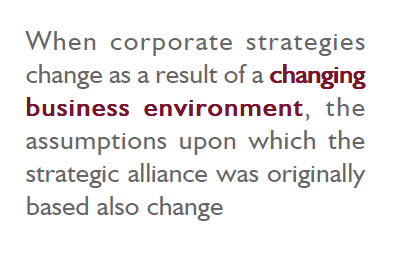“Strategic” may be one of the most over-used words in business today. This observation is especially valid in the world of alliances, where managers must distinguish between those alliances that are merely conventional and those that are truly strategic. This author outlines the five factors that make an alliance “strategic.”
As companies gain experience in building alliances, they often find their portfolios ballooning with partnerships. While these partnerships may contribute value to the firm, not all alliances are in fact strategic to an organization. This is a critical point, since, as this article will explain, those alliances that are truly strategic must be identified clearly and managed differently than more conventional business relationships.
Due to the levels of organizational commitment and investment required, not all partner relationships can be given the same degree of attention as truly strategic alliances. The impact of mismanaging a strategic alliance or permitting it to fall apart can materially impact the firm’s ability to achieve its core business objectives.
The five criteria of a “strategic” alliance
What is it that makes an alliance truly strategic to a particular company? Is it possible for an alliance to be strategic to only one of the parties in a relationship? Many alliances default to some form of revenue generation—which is certainly important— but revenue alone may not be truly strategic to the objectives of the business. There are five general criteria that differentiate strategic alliances from conventional alliances. An alliance meeting any one of these criteria is strategic and should be managed accordingly.
1. Critical to the success of a core business goal or objective.
2. Critical to the development or maintenance of a core competency or other source of competitive advantage.
3. Blocks a competitive threat.
4. Creates or maintains strategic choices for the firm.
5. Mitigates a significant risk to the business.
The essential issue when developing a strategic alliance is to understand which of these criteria the other party views as strategic. If either partner misunderstands the other’s expectation of the alliance, it is likely to fall apart. For example, if one partner believes the other is looking for revenue generation to achieve a core business goal when in reality the objective is to keep a strategic option open, the alliance is not likely to survive.
Examining each of the five strategic criteria in depth provides insight into how the strategic value of alliances can be leveraged.
1. Critical to a business objective
While the most common type of alliance generates revenue through a joint go-to-market approach, not every alliance that produces revenue is strategic. For example, consider the impact on revenue objectives if the relationship were terminated? Clearly, a truly strategic relationship would have a great bearing on the prospects for achieving revenue growth targets.

In addition to a single strategic alliance, related groupings of alliances—networks or constellations—may also be critical to a business objective. Sun Microsystems has established a group of integrator alliances that function as an effective marketing channel and drive significant revenues for the company each quarter. (See article, Constellation Strategy, elsewhere in this issue of IBJ Online).
 This category also includes alliances with high potentials, such as alliances that have large but unrealized revenue opportunities. Consider the impact of new industry standards that make it possible for products from different manufacturers to work together. This can unlock customer value and boost the revenue potential of new, technology-based products. From writable DVD formats to next-generation wireless technologies, technical standards are democratically determined in consortiums of interested industry participants. With product development racing in parallel, the first mover’s advantage can be substantial, and hence alliance development and lobbying within an industry become paramount to financial success.
This category also includes alliances with high potentials, such as alliances that have large but unrealized revenue opportunities. Consider the impact of new industry standards that make it possible for products from different manufacturers to work together. This can unlock customer value and boost the revenue potential of new, technology-based products. From writable DVD formats to next-generation wireless technologies, technical standards are democratically determined in consortiums of interested industry participants. With product development racing in parallel, the first mover’s advantage can be substantial, and hence alliance development and lobbying within an industry become paramount to financial success.
Cost reduction may also be a core business objective of the alliance, particularly among supply-side partners. By investing together in new processes, technologies, and standards, alliance partners can obtain substantial cost savings in their internal operations. Again, however, a cost-saving alliance is not truly strategic unless it has an underlying business objective, such as “to achieve an industry-leading cost structure.”
2. Competitive advantage and core competency
Another way in which an alliance can prove to be strategic is to play a key role in developing or protecting a firm’s competitive advantage or core competency. Learning alliances are the most common form of competitive/competency strategic alliances. An organization’s need to build incremental skills in an area of importance is often accelerated with the help of an experienced partner. In some cases, the learning objective of the relationship is openly agreed upon between the partners; however, this is not always the case. Learning alliances work best when:
1. The objectives are openly shared
2. There is little chance of future competition (such as when the partners are in adjacent industries)
3. The cultures of the organizations are similar enough to enable process and methods to be leveraged, and
4. The governance structure of the alliances is established to promote learning at the executive, managerial and operational levels.
3. Blocking a competitive threat

An alliance can be strategic even when it falls short of establishing a competitive advantage. Consider the case of an alliance that blocks a competitive threat. It is strategic to bring competitive parity to the second segment of a market in which the firm competes when the absence of parity creates a competitive disadvantage in the related primary segments of that market. For example, competing in the high and medium price range of a market with a premium product may leave the firm vulnerable to a low-priced entry. If the firm’s manufacturing processes do not permit the creation of a low-priced product entry, a strategic alliance with a volume partner in an adjacent market can successfully block the competitive threat.
Another example of strategic alliances that block competitive threats is the airline alliances that permit route-sharing among carriers. The two primary determinants of customer flight selection are routing and cost. Therefore, the adoption of route-sharing alliances by the airlines blocks the competitive threat of preferential routing in the specific markets in which the airline chooses to compete. In essence, strategic alliances within the airline industry ensure competitive parity with respect to routing and force other factors such as on-time departures and customer service to become the basis for competitive differentiation.
4. Future strategic options
From a longer-term perspective, an alliance that is not fundamental to achieving a business objective today could become critical in the future. For example, in 1984, a U.S. consumer products company needed to expand distribution beyond the Midwestern states. Faced with the prospect of European competition at some point in the future, the firm made a strategic decision to invest in an alliance with a distribution and support services company that had incremental distribution capacity in the U.S. and a similar presence in Europe, rather than invest in expanding its own local distribution capabilities. With the option to expand into European distribution at any point, the firm could work to sew up the U.S. market before expanding too quickly internationally.
 5. Risk mitigation
5. Risk mitigation
When an alliance is driven by the intent to mitigate significant risk to an underlying business objective, the nature of the risk and its potential impact on the underlying business objective are the key determinants of whether or not it is truly strategic. Dual sourcing strategies for critical production components or processes are excellent examples of how risk mitigation can become the context for supply-side strategic alliances.
As process manufacturing companies advance the yield of their operations, suppliers often collaborate with the manufacturer to ensure their new products fit within their new operations. The benefits of such an alliance are cost savings to the manufacturer and accelerated product development for the supplier. In situations where the supplier’s product is critical to the manufacturer’s operation, it may be necessary for the manufacturer to have strategic alliances with two competing suppliers in order to mitigate such risks as unilateral cost increases or degradation in the quality of service.
Joint ventures and minority equity investments

Among relationship commitments, joint ventures and equity investments are closest to the strategic end of the spectrum. However, investing a large sum of money in a partner does not automatically make the relationship strategic. One needs only to survey the wreckage of the dot-com era for proof of failed minority equity investments in alliances. It may be economically sound to invest $1 million in a distribution relationship that is projected to return $1.5 million in incremental sales the following year. This would not necessarily be strategic to a firm with $800 million in annual sales unless the alliance also served an alternate purpose that met one of the five strategic criteria. For example, if the achievement of a core business objective, such as access to a new market, were enabled by the investment, then it would be strategic to the firm.
Management
How, then, should strategic alliances be managed differently than traditional alliances? There are countless lists of reasons why alliances fail. However, aside from ensuring “sound strategic alignment” between the partners, most determinants of failure are less than strategic in nature.
Lack of executive sponsorship is often a source of alliance failure. With strategic alliances, the key to effective executive sponsorship is visibility and accountability. Since failed alliances can directly impact a business in a meaningful way, or even have adverse implications for the executive’s own financial bonus or prestige, he has a strong incentive to consider the strategic alliance as important as his other primary responsibilities.
Metrics determine just how the alliance and account executives are kept on track. While clear metrics are required of any alliance, shared metrics between the partners are absolutely critical to the success of a strategic alliance. Shared metrics bring immediate alignment of focus between the parties, and when executive sponsors are held accountable for the shared metrics, the two firms become aligned as one.
Poor alliance governance structures are another common source of alliance failure. Strategic alliances are best served by formalized governance structures with clear mandates that are directly linked to the shared metrics underpinning the partnership. At Hewlett-Packard, we often create strategic alliance executive committees using an “N by N” mapping of key HP executives to their counterparts at the alliance partner. The number (“N”) and position of the executives participating in the review meetings—usually on a quarterly basis—are tailored to the specifics of each strategic alliance. The attending executives represent the business unit(s) and core functions that are critical to the execution of the strategic alliance.
Regular meetings of executives from the partner companies continue the relationship building that begins while formulating and negotiating the terms of the strategic alliance. Trust is perhaps the foundation of a strategic alliance and these relationships are the building blocks for establishing trust amongst the individuals who represent the two parties in the strategic alliance.
The real reason that most alliances fail is the constant change in the business environment. Trust allows the parties in a strategic alliance to have difficult discussions that will transform the alliance over time and give it longevity. When corporate strategies change as a result of a changing business environment, the assumptions upon which the strategic alliance was originally based also change. What was once a strategic investment may no longer remain strategic without modification to the terms of the alliance? In the most extreme cases, the trust built between the two companies enables the adaptability—even renegotiation of the financial terms—to accommodate changes in the market or other conditions that impact one of the partners.
Strategic alliance organizations are feeling increased pressure. As critical personnel becomes stretched and financial resources become scarce, strategic alliance organizations must allocate their resources in the most efficient manner possible so that truly strategic alliances can support and accelerate the strategy of the business. The five strategic criteria outlined in this article are primary determinants of the strategic value of an alliance. Using these criteria to identify genuine strategic alliances in the portfolio today and as a guide for developing future strategic alliances are the first steps to improving the impact of an alliance organization. The management principles also described above, are the next steps towards improving the effectiveness of the strategic alliances themselves.
 All 4 One Alliance Legal
All 4 One Alliance Legal 